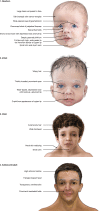Noonan syndrome: improving recognition and diagnosis
- PMID: 35246453
- PMCID: PMC9685729
- DOI: 10.1136/archdischild-2021-322858
Noonan syndrome: improving recognition and diagnosis
Abstract
Noonan syndrome (NS) is a mostly dominantly inherited disorder affecting 1:1000 to 1:2500 live births. The phenotype varies in severity and can involve multiple organ systems over a patient's lifetime. Diagnosis is based on a combination of features, including typical facial features, short stature, skeletal abnormalities, presence of cardiac defects, mild developmental delay, cryptorchidism, lymphatic dysplasia and a family history of NS. The phenotype varies from oligosymptomatic adults without significant medical issues to severely affected neonates with life-threatening heart disease. Early, accurate diagnosis is important for individualised management and to optimise developmental and long-term outcomes, but mildly affected patients often go undiagnosed for both healthcare provider (HCP)-related and patient-related reasons. Lack of awareness of NS among HCPs means that some do not recognise the condition, particularly in mildly affected patients and families. Some families do not want to receive a diagnosis that medicalises a condition that may account for family traits (eg, distinctive facial features and short stature), particularly when a child's physical and cognitive development may be satisfactory. As for any condition with lifelong effects on multiple organ systems, a multidisciplinary approach provides the best care. It is proposed that increasing awareness of NS among non-specialist HCPs and other professionals could help direct a parent/carer to seek specialist advice and increase the number of NS diagnoses, with the potential to optimise lifelong patient outcomes. Non-specialists do not need to become experts in either diagnosis or treatment; however, early recognition of NS and referral to an appropriate specialist is important.
Keywords: endocrinology; genetics; syndrome.
© Author(s) (or their employer(s)) 2022. Re-use permitted under CC BY-NC. No commercial re-use. See rights and permissions. Published by BMJ.
Conflict of interest statement
Competing interests: The concept for this paper came about during discussions at an advisory board meeting organised and supported by Novo Nordisk Health Care, for which all attendees (JCB, MC, TE, MZ) received an honorarium. MZ has nothing further to disclose. TE passed his honorarium to the INSERM unit UMR 1043. He received research funding from Pfizer. JCB is a member of the Publication Steering Committee of a research study funded by Novo Nordisk Health Care and has received payment for this. She has received consultancy fees, honoraria and support to attend scientific meetings, also from Novo Nordisk Health Care. MC has had consultancy agreements with COR2ED, Merck Serono, Novo Nordisk Health Care, BlubirdBio and Ipsen. He has received honoraria for lectures from Novo Nordisk Health Care, Eli Lilly and Ipsen.
Figures



References
-
- Stevenson DA. Bmj best practice: Noonan syndrome: BMJ, 2018. Available: https://bestpractice.bmj.com/topics/en-us/1193 [Accessed 09 Dec 2019].
Publication types
MeSH terms
LinkOut - more resources
Full Text Sources
Medical
Research Materials
Miscellaneous
